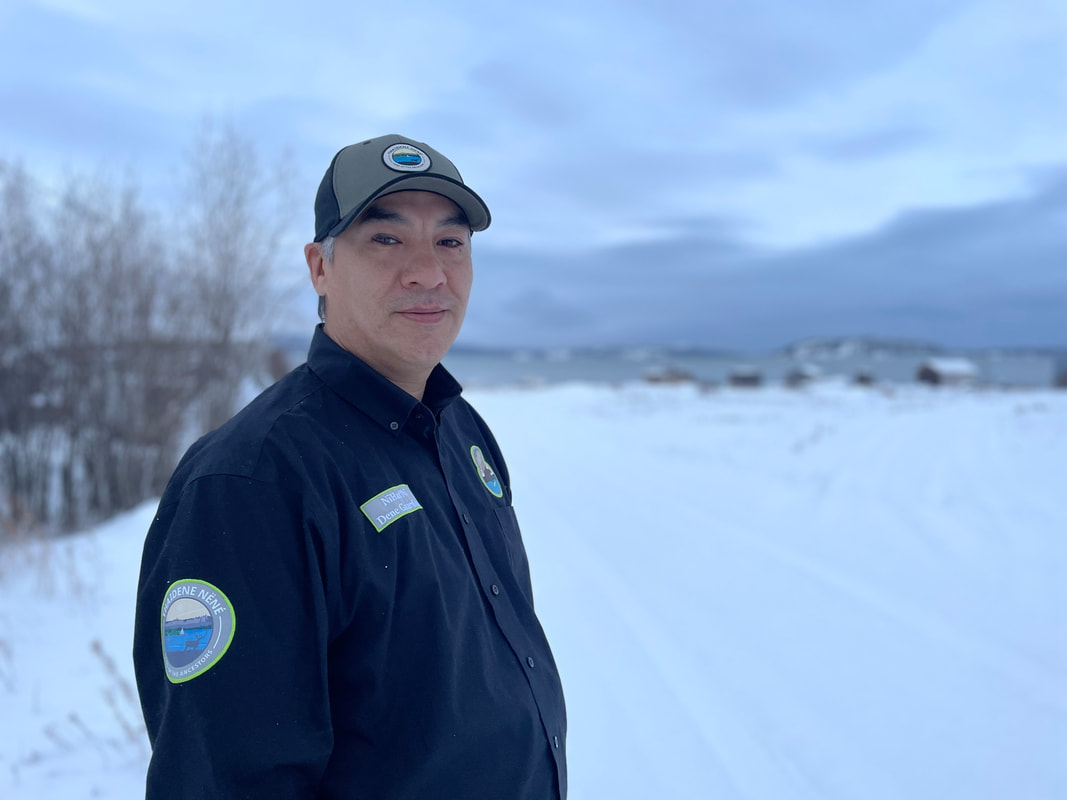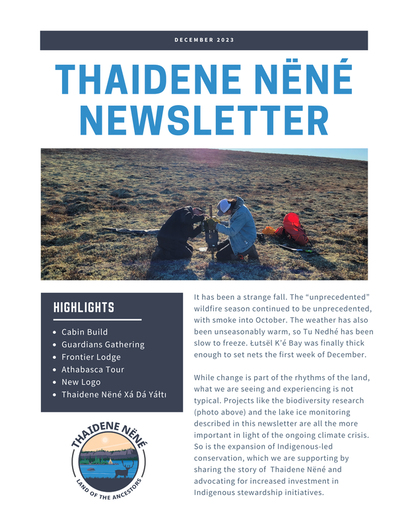 Adrian Nataway wanted to be a Ni Hat’ni Dene guardian because, in his words, “the land, the water, the animals, they mean everything.” “It is important,” he says, “that we are watching, that we are paying attention to how the land, the water, and the animals are doing, that we are noticing any changes.” The Ni Hat’ni Dene crew have accomplished quite a bit since Adrian started in July 2023. “We put up seven platforms at different places in the protected area. We tore down one old cabin, did a retrofit of another cabin, and now we’re building a new cabin at Old Snowdrift. We also provided food security during the fires and evacuation by harvesting meat like muskox, moose, and rabbits, and fish, and sharing it with community members.” Adrian attributes the guardians’ accomplishments to having such a big and knowledgeable crew. “We’ve been doing a lot of different things,” he says. “It makes it easier because there are so many hands and those hands know what they’re doing.” Adrian made a special point to say how much he likes working with people of different ages. “These young guys make you feel so energetic!” Likewise, Adrian is appreciated by his colleagues for what he brings to the job, not least of which is his work ethic. Adrian is also a people person. He likes meeting and interacting with visitors to Thaidene Nëné. He also has a knack for fixing things. His training and experience in small engine repair often come in handy. Adrian was raised in Łutsël K’é by his grandparents, Bruno and Marie Nataway. They taught him how to live on the land, how to hunt, and camp. But perhaps most importantly they passed on their language. Adrian is fluent in Dënesųłıné yatı. This has been invaluable for Adrian in his work as a guardian because he is able to communicate with the Elders. Adrian lived away from Łutsël K’é for a while. He returned to the community almost two decades ago. Even after he moved home, work took him away from his common-law partner, Stephanie, and their children. “You miss lots during your two weeks away,” he says about the years working in the mines. “It’s nice to be able to stay home, to have a job here.” While all of Thaidene Nëné is important to Adrian, Ts’ąkuı Thedá (Lady of the Falls) on Ts'ąkuı Thedá Dezé (Lockhart River) is particularly special. He’s done the hike from Desnéthchée to the falls. “It’s quite the trip,” he says. “You’ve got to be physically fit because it’s a physically demanding trail. It’s also a hard trail to find if you don’t know it, but it’s worth it to be there with her.” Adrian was a band councillor during the negotiations. “I wanted Thaidene Nëné to be so massive,” he remembers. “The whole time they just kept making it smaller and smaller. A lot of things got left out.” He hopes that the area under protection can be increased through the Akaitcho land claim process. “When we do our land claim, we should have a buffer zone around the current boundaries so we have even more protection. Thaidene Nëné is just one step. It’s important that we think in that way.”  The December 2023 newsletter has stories about: the Thaidene Nëné Department's cabin build happening at Old Snowdrift; the delegation from Łutsël K’é Dene that travelled to five communities in the Athabasca region to share the story of Thaidene Nëné; Frontier Lodge being named Operator of the Year by Northwest Territories Tourism, and more. We will put hard copies of the newsletter in community mailboxes soon. Until then, you can read the digital version by clicking on the button below. FOR IMMEDIATE RELEASE
November 14, 2023 We are delighted and honoured to announce that Frontier Lodge has been named NWT Tourism’s operator of the year for 2023. The award was one of three handed out at a dinner and celebration during NWT Tourism’s annual conference in Yellowknife. On hand to receive the award was our board president, Saniz Catholique-Baton, and general manager, Corey Myers. “We are very humbled and honoured by the recognition. Connecting the community and culture, and maintaining the business through a pandemic and now wildfire evacuations has been a challenge. But through it all we continue to work towards the best future for our lodge and the North. Corey has done a great job as our manager. Our priority is always Frontier and our guests, but we always bring it back to the community, in any decisions we make and how we can all work together. This award highlights our commitment to the betterment of our lodge and community, through the growth of tourism in Thaidene Nené. We're very proud of what we've accomplished so far and will use this award as motivation moving forward. Mahsı,” says Saniz Catholique-Baton, Łútsël K’é Dene First Nation member and president of the Frontier Lodge board Frontier was honoured to be recognized alongside Jackie Challis, the former tourism director for the town of Inuvik, who was given the lifetime achievement award, and Cabin Radio, who received the service excellence award for its coverage of the summer’s wildfires and evacuations. The operator of the year award is given to an operator who has “demonstrated all-around excellence and models best practices in the industry resulting in strong growth and/or a record of success.” The award also recognizes “commitment to education and training” and “community involvement and leadership.” The lodge was nominated by Jackpine Paddle owner Dan Wong for our efforts to support the community of Łútsël K’é and others stranded on the East Arm after the evacuation of Yellowknife due to wildfires in August of this year. Not only did Frontier donate all of our remaining food to Łútsël K’é after the lodge’s season was abruptly ended, but we worked with the Łútsël K’é Co-op to fly food into the community, ensuring Łútsël K’é was able to weather the disrupted supply chain. The Frontier team also provided logistical support and assistance to others in the area at that difficult time, including staff and guests of Jackpine Paddle. “Like every operator we’ve been through a lot in the past four years, and we’ve tried to put our best foot forward every step of the way, including when things got tough this year with the fires and evacuations,” says general manager Corey Myers. For more than 60 years, Frontier Lodge has welcomed fishing enthusiasts from around the world to the East Arm of Tu Nedhé (Great Slave Lake). While we continue to offer world-class fishing experiences to international clientele, there have been important changes at Frontier since the Łútsël K’é Dene First Nation purchased the lodge in 2019. Perhaps most important is the work that has been done to connect the lodge to the land and the Dënesųłıné people who have called this place home since time immemorial. Through community meetings and interviews with local Elders, we made a plan to ensure that local history, traditions, stories, and culture are shared with our guests in a respectful and appropriate way. Seven culturally significant places from across Thaidene Nëné (the Land of the Ancestors) were selected to be the themes for our rejuvenated guest cabins. Through bilingual signage; local paintings, carvings, and hides; archival photographs; and Elders’ stories, guests are surrounded by Dënesųłıné history and culture when they visit Frontier. We are currently developing scholarship opportunities for Łútsël K’é Dene First Nation members and making plans to hire a cultural officer. In addition to NWT Tourism and our nominator, Dan Wong, we would like to thank our hard-working board of directors, the incredible support from the community of Łútsël K’é, our dedicated staff, our loyal client base, and our partners at GNWT Department of Industry, Tourism and Investment, CANNOR, Parks Canada, Account on Us, Aurora Geoscience, Daryl’s Shuttle Service, Summit Air, Air Tindi, Łútsël K’é Co-op, Gordon Food Service, the Chateau Nova, and the Explorer Hotel. “As Chief of the Łútsël K’é Dene First Nation, I am very pleased that our Indigenous tourism operation, Frontier Lodge, has been recognized by NWT Tourism with this award. The Łútsël K’é Dene First Nation is proud to own and operate a world-class fishing lodge. The Łútsël K’é Dene First Nation and our members look forward to welcoming visitors to Thaidene Nëné, the land of our ancestors, and our Dënesųłıné territory,” says Chief James Marlowe. Contact: Corey Myers General Manager Frontier Lodge 877-465-6843 frontier.fishing@gmail.com Our collaborators and colleagues in conservation currently have the following job opportunities available: Slave/Talston Indigenous Protected and Conserved Area Project The Slave/Taltson IPCA Project (via DKFN/FRMG) is seeking an Indigenous Protected and Conserved Area (IPCA) Coordinator. This is initially a term position to March 2025. Taking direction from the Slave/Taltson IPCA committee the IPCA Coordinator will lead project management for the proposed community IPCA referred to as the Slave/TaItson IPCA Project. The deadline to apply is November 17, 2023. Government of the Northwest Territories
The Conservation, Planning, and Implementation Unit in the GNWT's Department of Environment and Climate Change is hiring for two positions. Manager, Conservation Planning (2 yr term) Located in Yellowknife and reporting to the Director, Conservation and Sustainable Livelihoods (Director), the Manager, Conservation Planning directly supervises 8 full time staff as well as associated casual positions. Please note: This job opening is limited to employees with the GNWT/WSCC in indeterminate and term positions. For more information, visit: https://www.gov.nt.ca/careers/en/job/24385. Senior Conservation Areas Advisor (1 yr Term) The Senior Conservation Areas Advisor (Senior Advisor) supports the establishment of conservation areas and manages Government of Northwest Territories (GNWT)'s partnership, including promoting the conservation and advancing GNWT roles associated with candidate conservation areas. For more information, visit https://www.gov.nt.ca/careers/en/job/24386.
You can learn more about all of these activities in the October newsletter. You can also read a report on the wildfire season and get updates on Thaidene Nëné Xá Dá Yáłtı and Frontier Lodge.
|
AuthorWrite something about yourself. No need to be fancy, just an overview. Archives
March 2024
Categories |
CONNECT |
VISIONWe are the Lutsel K’e Dene First Nation. Our vision for Thaidene Nëné is:
Nuwe néné, nuwe ch'anıé yunedhé xa (Our land, our culture for the future). We’re working with our partners to permanently protect Thaidene Nëné—part of our huge and bountiful homeland around and beyond the East Arm of Tu Nedhé. |
